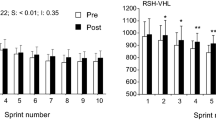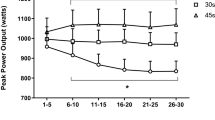Abstract
The influence of training status on the maximal accumulated oxygen deficit (MAOD) was used to assess the validity of the MAOD method during supramaximal all-out cycle exercise. Sprint trained (ST; n = 6), endurance trained (ET; n = 8), and active untrained controls (UT; n = 8) completed a 90 s all-out variable resistance test on a modified Monark cycle ergometer. Pretests included the determination of peak oxygen uptake (\(\dot V\)O2peak) and a series (5–8) of 5-min discontinuous rides at submaximal exercise intensities. The regression of steady-state oxygen uptake on power output to establish individual efficiency relationships was extrapolated to determine the theoretical oxygen cost of the supramaximal power output achieved in the 90 s all-out test. Total work output in 90 s was significantly greater in the trained groups (P<0.05), although no differences existed between ET and ST. Anaerobic capacity, as assessed by MAOD, was larger in ST compared to ET and UT. While the relative contributions of the aerobic and anaerobic energy systems were not significantly different among the groups, ET were able to achieve significantly more aerobic work than the other two groups, while ST were able to achieve significantly more anaerobic work. Peak power and peak pedalling rate were significantly higher in ST. The results suggested that MAOD determined during all-out exercise was sensitive to training status and provided a useful assessment of anaerobic capacity. In our study sprint training, compared with endurance training, appeared to enhance significantly power output and high intensity performance over brief periods (up to 60 s), yet few overall differences in performance (i.e. total work) existed during 90 s of all-out exercise.
Similar content being viewed by others
References
Armon Y, Cooper DM, Flores R, Zanconato S, Barstow TJ (1991) Oxygen uptake dynamics during high-intensity exercise in children and adults. J Appl Physiol 70: 841–848
Åstrand PO (1981) Aerobic and anaerobic energy sources in exercise. Med Sport Sci 13: 22–37
Åstrand PO, Rodahl K (1986) Textbook of work physiology. Physiological basis of exercise. McGraw-Hill, New York
Åstrand PO, Saltin B (1961) Oxygen uptake during the first minutes of heavy muscular exercise. J Appl Physiol 16: 971–976
Bangsbo J (1992) Is the O2 deficit an accurate quantitative measure of the anaerobic energy production during intense exercise? Letters to the editor. J Appl Physiol 73: 1207–1208
Bangsbo J, Gollnick PD, Graham TE, Juel C, Kiens B, Mizuno M, Saltin B (1990) Anaerobic energy production and OZ deficit-debt relationships during exhaustive exercise in humans. J Physiol 422: 539–559
Bangsbo J, Michalsik A, Petersen A (1993) Accumulated O2 deficit during intense exercise and muscle characteristics of elite athletes. Int J Sports Med 14: 207–213
Bergh U, Sjodin B, Forsberg A, Svedenhag J (1991) The relationship between body mass and oxygen uptake during running in humans. Med Sci Sports Exerc 23: 205–211
Blomstrand E, Ekblom B (1982) The needle biopsy technique for fibre type determination in human skeletal muscle — a methodological study. Acta Physiol Scand 116: 437–442
Bouchard C, Boulay MR, Simoneau J, Lortie G, Perusse L (1988) Heredity and trainability of aerobic and anaerobic performances: an update. Sports Med 5: 69–73
Coast JR, Welch HG (1985) Linear increase in optimal pedal rate with increased power output in cycle ergometry. Eur J Appl Physiol 53: 339–342
Craig NP, Norton KI, Bourdon PC, Woolford SM, Stanef T, Squires B, Olds TS, Conyers RAJ, Walsh CBV (1993) Aerobic and anaerobic indices contributing to track endurance cycling performance. Eur J Appl Physiol 67: 150–158
Davies CTM, Sandstrom ER (1989) Maximal mechanical power output and capacity of cyclists and young adults. Eur J Appl Physiol 58: 838–844
Gastin PB (1994) Quantification of anaerobic capacity. Scand J Med Sci Sports 4:91–112
Gastin PB, Lawson DL (1994) Variable resistance all-out test to generate accumulated oxygen deficit and predict anaerobic capacity. Eur J Appl Physiol 69:331–336
Gastin PB, Costill DL, Lawson DL, Krzeminski K, McConell GK (1994) Accumulated oxygen deficit during supramaximal all-out and constant intensity exercise. Med Sci Sports Exerc, in press
Gastin P, Lawson D, Hargreaves M, Carey M, Fairweather I (1991) Variable resistance loadings in anaerobic power testing. Int J Sports Med 12: 513–518
Gollnick PD, Bayly WM, Hodgson DR (1986) Exercise intensity, training, diet, and lactate concentration in muscle and blood. Med Sci Sports Exerc 18: 334–340
Gramvik P (1990) Anaerobic energy release during 10 and 30 s bicycle sprints. Thesis, Norwegian University of Physical Education and Sports, Oslo
Hermansen L, Medbø JI (1984) The relative significance of aerobic and anaerobic processes during maximal exercise of short duration. Med Sport Sci 17: 56–67
Lawson DL, Golding LA (1981) Maximal oxygen deficit as an indicator of anaerobic potential. Aust J Sport Sci 9: 1–5
Linnarsson D, Karlsson J, Fagraeus L, Saltin B (1974) Muscle metabolites and oxygen deficit with exercise in hypoxia and hyperoxia. J Appl Physiol 36: 399–402
McKenna MJ, Green RA, Shaw PF, Meyer ADMcR (1987) Tests of anaerobic power and capacity. Aust J Sci Med Sport 19: 13–17
Medbø JI (1991) Quantification of the anaerobic energy release during exercise in man. Thesis, University of Oslo, Norway
Medbø JI (1992) Letters to the editor. J Appl Physiol 73: 1208–1209
Medbø JI, Tabata I (1989) Relative importance of aerobic and anaerobic energy release during short-lasting exhaustive bicycle exercise. J Appl Physiol 67: 1881–1886
Medbø JI, Burgers S (1990) Effect of training on the anaerobic capacity. Med Sci Sports Exerc 22: 501–507
Medbø JI, Mohn A, Tabata I, Bahr R, Vaage O, Sejersted OM (1988) Anaerobic capacity determined by maximal accumulated O2 deficit. J Appl Physiol 64: 50–60
Nevill AM, Ramsbottom R, Williams C, Winter EM (1991) Scaling physiological performance measures for individuals of different body size. J Sports Sci 9: 427–428
Saltin B (1990) Anaerobic capacity: past, present, and future. In: Taylor AW, Gollnick PD, Green FU, Ianuzzo CD, Noble EG, Metivier G, Sutton JR (eds) Biochemistry of exercise VII. Human Kinetics, Champaign, Ill., pp 387–412
Scott CB, Roby FB, Lohman TG, Bunt JC (1991) The maximally accumulated oxygen deficit as an indicator of anaerobic capacity. Med Sci Sports Exerc 23: 618–624
Serresse O, Lortie G, Bouchard C, Boulay MR (1988) Estimation of the contribution of the various energy systems during maximal work of short duration. Int J Sports Med 9: 456–460
Simoneau JA, Lortie G, Boulay MR, Bouchard C (1983) Tests of anaerobic alactacid and lactacid capacities: description and reliability. Can J Appl Sport Sci 8: 266–270
Simoneau JA, Lortie G, Boulay MR, Marcotte M, Thibault MC, Bouchard C (1986) Inheritance of human skeletal muscle and anaerobic capacity adaptation to high-intensity intermittent training. Int J Sports Med 7: 167–171
Szogy A, Cherebetiu G (1974) Minutentest auf dem Fahrradergometer zur Bestimmung der anaeroben Kapazitat. Eur J Appl Physiol 33: 171–176
Thomson JM, Garvie KJ (1981) A laboratory method for determination of anaerobic energy expenditure during sprinting. Can J Appl Sport Sci 6: 21–26
Vandewalle H, Peres G, Heller J, Monod H (1985) All out anaerobic capacity tests on cycle ergometers. Eur J Appl Physiol 54: 222–229
Vandewalle H, Peres G, Monod H (1987) Standard anaerobic exercise tests. Sports Med 4: 268–289
Weyand PG, Cureton KJ, Conley DS, Higbie EJ (1993) Peak oxygen deficit during one- and two-legged cycling in men and women. Med Sci Sports Exerc 25: 584–591
Withers RT, Sherman WM, Clark DG, Esselback PC, Nolan SR, Mackay MH, Brinkman M (1991) Muscle metabolism during 30, 60, and 90 s of maximal cycling on an air-braked ergometer. Eur J Appl Physiol 63: 354–362
Whipp BJ (1971) Rate constant for the kinetics of oxygen uptake during light exercise. J Appl Physiol 30: 261–263
Whipp BJ, Wasserman K (1972) Oxygen uptake kinetics for various intensities of constant-load work. J Appl Physiol 33: 351–356
Whipp BJ, Wasserman K (1986) Effect of anaerobiosis on the kinetics of O2 uptake during exercise. Fed Proc 45: 2942–2947
Author information
Authors and Affiliations
Rights and permissions
About this article
Cite this article
Gastin, P., Lawson, D. Influence of training status on maximal accumulated oxygen deficit during all-out cycle exercise. Eur J Appl Physiol 69, 321–330 (1994). https://doi.org/10.1007/BF00392038
Accepted:
Issue Date:
DOI: https://doi.org/10.1007/BF00392038




